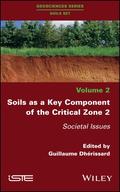Soils as a Key Component of the Critical Zone 2
Societal Issues

1. Edition August 2018
176 Pages, Hardcover
Wiley & Sons Ltd
This volume comprises three parts: 1) from local to global, 2) what type of sustainable management? 3) territorial approaches. The first chapter demonstrates, from the French example, that better soil management is a societal issue. At the global level, the second chapter raises the question of land grabbing and land use conflicts. This book also raises the question of the legal status of the soil. It then shows how soils need to be integrated when defining sustainable agricultural systems. French and European examples illustrate how taking environmental problems into account depends as much on their acuity as on how problems are perceived by public and private, social or economic actors. Therefore, it is important to promote co-diagnosis involving the scientific community and the various other actors in order to improve the regulation on soils. This multi-actor soil governance is facilitated by the use of simple soil quality indicators. Finally, examples in France and Vietnam show how soils are to be considered as territorial commons within landscapes. This last chapter recommends in particular to put an end to the absolute right of soil ownership and to distribute the usufruct of land between various private and public beneficiaries.
2. Land grabbing.
3. The soil: an unidentified object of right.
4. Soils in the design of sustainable agricultural systems.
5. Orchestrating dialogue among actors: co-diagnosis and evaluation of progress.
6. Soil quality governance, a complex and multi-actor dynamic.
7. Soils as territorial commons: a landscaper point of view.


